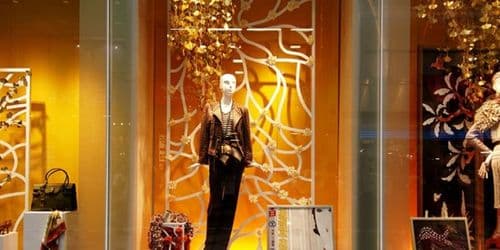A visual merchandiser is in charge of product display in retail stores and retail store windows. As an expert in this sector, you design the interior and exterior of the business to highlight things that will encourage customers to buy. This article will explain how to become a visual merchandiser, and cover the duties and skills required for this position with their average salary.
What is a Visual Merchandiser?
A visual merchandiser is in charge of product displays in retail store windows and on store floors. As a visual merchandiser, you design the external and interior displays of the store to exhibit products with the appropriate style and look that persuade customers to make purchases. You are in charge of selecting and implementing display sceneries and merchandise. Your job is to make store windows and other displays appealing and on-brand.
How to Become a Visual Merchandiser
To operate as a visual merchandiser, you must have a background in design and marketing as well as retail expertise. Some visual merchandiser jobs just require an associate’s degree, while others demand a bachelor’s degree in design or a similar discipline. To develop the skills necessary for this vocation, you should study color theory, layout, and marketing.
What are the Duties and Responsibilities of a Visual Merchandiser?
The day-to-day duties of a visual merchandiser vary depending on the type and size of the employer, the nature of projects, and the level of responsibility. A visual merchandiser may undertake the following duties while on the job:
- Improve the layout and space of a store.
- Set up mummy costumes and exhibits
- Product display lighting and color palette
- Instructions should be given to the sales department on how to color harmonize counter displays and cloth racks.
- Participate in business planning meetings.
- Provide timely input to purchasing teams and the corporate headquarters.
- Communicate with the promotional and marketing teams.
- Set up display cases, displays, counters, and garment racks.
- Marketers should be sold on a display concept.
- Keep track of goods sales in each retail location.
Working as a visual merchandiser entails traveling between retail outlets and working from headquarters. Depending on your company and the responsibility of a specific store, you can also take responsibility for one store—some visual merchandisers create utilizing computer software to attract more people to their businesses.
The physical execution of item designs is another area of concentration for visual merchandisers. To be a good visual merchandiser, you must possess imaginative skills in order to create interesting displays, counters, and other objects that will draw customers to the company’s merchandise. Visual merchandisers also have the following duties:
#1. Influence the consumer experience
Retail stores can still thrive in the face of online purchasing, and visual merchandisers can create displays that promote the company’s brands. Customers continue to make purchases in both online and brick-and-mortar establishments, where the journey begins with drawing customers. Stores can attract more customers with a visually appealing window display. Great merchandising is an effective method for persuading shoppers to pause and consider purchasing at your store. Visual merchandisers assist retail establishments in luring clients by:
- Products highlighted
- Displays that are well-lit
- Products that have been hand-picked
- The color palette is limited.
- Props that are the right size
- Customers will be drawn in by creative product displays.
Signage, product displays, personal interaction, and other marketing methods are used by visual merchandisers to attract potential customers to a retail business. To draw customers to their establishments, visual merchandisers might use three crucial elements:
#2. Displays in windows:
To entice potential shoppers inside the stores, communicate the design, content, style, and price message.
Create a merchandise zone and hierarchy on the floor map to determine goods placement in store display windows. Attract customers with well-organized merchandise in stores.
Tables and wall hangings: Create a consumer experience with appealing displays, lighting, and hanging floor by presenting a display plan.
#3. Features and walls:
Engage customers as they enter your stores, transition areas, and retail sections using fixtures, furniture, and visual messaging, including photography and digital material.
#4. Display the store’s brand.
Visual merchandisers can influence your merchandise brand’s feel, style, and culture. They can raise brand awareness while also increasing brand loyalty. The aesthetic quality of your item display can entice customers and complete the transaction. When you successfully showcase a brand, you improve the customer experience, increase sales, and receive favorable customer feedback.
What a Good Visual Merchandiser?
A successful Visual Merchandiser possesses the appropriate combination of product knowledge, style, marketing skills, and design sensibility. They must be aware with the store’s merchandise and current trends, as well as design interesting and well-presented displays that are appealing to customers. They are inventive while remaining focused on showcasing the store’s merchandise.
Some visual merchandiser skills to have include:
#1. Create new concepts.
Being creative is one of the most important skills for a good visual merchandiser. This industry’s professionals are creative and use their extensive design skills to develop visuals and concepts for a certain service or product. They entice customers to purchase brand products from their stores by creating visually appealing product displays.
#2. Communicate
You should have strong communication skills and understand how to communicate with merchants and consumers to be a successful visual merchandiser. Learn how to listen to retail store needs and create a strategy for communicating store messaging to potential customers. Determine the main message to convey and accurately capture it in the visual display.
#3. Recognize trends
Pay close attention to emerging visual merchandising trends to ensure your merchandising endeavor remains appealing and relevant. As a skilled merchandiser, you can obtain the most recent materials on the market, such as models, signs, items, equipment, and props. If you are aware of consumer preferences, apply your skills to design an appealing visual merchandising plan.
#4. Brand awareness
Delivering strategies and concepts that promote various store brands, services, and products is the primary responsibility of visual merchandisers. Create one-of-a-kind store displays to attract more people and boost revenue. If you understand a brand, collaborate with store managers, marketing teams, and retail buyers to attract customers.
#5. Control and organization
To coordinate and manage visual display projects as a visual merchandiser, you must possess exceptional organizing skills. While implementing visual merchandising plans, you anticipate to collaborate with colleagues, superiors, and subordinates. Many tasks must be coordinated, such as the acquisition of resources and supplies.
You anticipate spending the majority of your time in the office devising visual strategies and layouts, with the remainder of your time spent traveling to retail outlets, constructing displays, or acquiring props.
#6. Collaboration and supervision
Most of the time, you will be creating visual displays at work, as well as supervising employees and assigning them tasks to do. To instruct staff on how to display merchandise to attract customers and collaborate with marketing executives, buyers, retail reps, and other merchandisers to improve shop displays, you will need these skills.
#7. Design
The same as inventiveness. Another key visual merchandiser trait and ability is design. You must be skilled in designing, combining colors, and executing various styles while creating visual displays. Your design skills will affect how you market services and products, increase sales, improve the store experience, and attract customers.
Creating visually appealing displays can help a visual merchandiser gain recognition. To help you develop your artistic skills to the fullest, you should become familiar with Adobe Creative Suite or computer-aided design. Concentrate on training and development of these skills.
#8. Assist customers
Seek feedback from clients and provide excellent customer service. Learn about the customer service tactics and methods that can entice customers to acquire products or services from your store. Interact with customers to learn about the modifications they want to see in your retail display and to ensure that you match their expectations.
The Average Salary of a Visual Merchandiser
The average annual salary for Visual Merchandisers in the United States is $38,037, or $18 per hour. The top 10% earn more than $53,000 per year, while the bottom 10% earn less than $27,000 per year.
Types of Visual Merchandisers
There are various forms of visual merchandisers, such as:
#1. Graphic Designer:
Graphic designers are in charge of designing visual concepts using computer software or by hand. The ultimate goal of becoming a graphic designer is to inspire consumers. So being inventive is required.
A Bachelor’s degree is typically required for Graphic Designers, but having a well-rounded portfolio is likely the most significant item you can bring to an interview.
- Salary: $49,450 on average
- Degree: Bachelor of Arts
#2. Merchandiser
Role:
If you want to be a merchandiser, you should be prepared for a joyful job. Your job is to make the product as enticing as possible. So, if it means piling $1 hand pies by the cash register, fine.
Some merchandisers spend most of their time in the back finding merchandise and bringing it up front to the matching barcode area. You may occasionally arrange sale products in a showcase. At times, you may want to “dress up” the window display. Whatever entices the buyer to come in and buy it.
A merchandiser’s job is highly adaptable. There are many part-time jobs available in this job in addition to full-time ones. So you have complete control over how many hours you work. That is not something that many individuals can say about their job.
- Salary: $31,051 on average
- Degree: Bachelor of Science
#3. Designer
Role:
A career as a designer can take many different paths. You could create anything you wanted, from fashion designers to flower designers, graphic designers to interior designers, as long as you have an eye for detail and a steady hand.
The education required to become a designer varies based on the type of design you intend to accomplish. A floral designer, for example, simply needs a high school diploma, whereas a graphic designer may need a Bachelor’s degree. It all depends on the path you choose to pursue with your job.
- Average annual salary: $66,347
- Degree: Bachelor of Science
States With The Highest Number of Visual Merchandiser Jobs
| Rank | State | Number of Jobs | Average Salary |
| 1 | California | 5,233 | $47,527 |
| 2 | Texas | 2,899 | $35,220 |
| 3 | Florida | 2,404 | $37,025 |
| 4 | New York | 2,205 | $50,859 |
| 5 | Illinois | 2,045 | $38,528 |
| 6 | Pennsylvania | 1,839 | $49,662 |
| 7 | Michigan | 1,725 | $36,393 |
| 8 | Georgia | 1,558 | $34,075 |
| 9 | Ohio | 1,486 | $40,425 |
| 10 | Massachusetts | 1,437 | $43,174 |
| 11 | North Carolina | 1,389 | $44,098 |
| 12 | Indiana | 1,273 | $31,892 |
| 13 | Virginia | 1,233 | $45,510 |
| 14 | Washington | 1,118 | $40,978 |
| 15 | New Jersey | 1,109 | $44,638 |
| 16 | Minnesota | 1,104 | $34,867 |
| 17 | Colorado | 1,046 | $36,735 |
| 18 | Wisconsin | 944 | $45,392 |
| 19 | Missouri | 933 | $36,314 |
| 20 | Maryland | 899 | $44,420 |
| 21 | Arizona | 860 | $41,701 |
| 22 | Tennessee | 836 | $33,840 |
| 23 | Oregon | 661 | $38,325 |
| 24 | Louisiana | 568 | $35,226 |
| 25 | South Carolina | 525 | $36,018 |
| 26 | Oklahoma | 524 | $35,560 |
| 27 | Connecticut | 518 | $45,419 |
| 28 | Utah | 505 | $37,418 |
| 29 | Kansas | 484 | $34,729 |
| 30 | Alabama | 460 | $32,911 |
| 31 | Kentucky | 455 | $38,232 |
| 32 | Mississippi | 396 | $37,201 |
| 33 | Nebraska | 372 | $36,109 |
| 34 | Iowa | 346 | $35,049 |
| 35 | Arkansas | 311 | $33,402 |
| 36 | West Virginia | 294 | $41,456 |
| 37 | New Mexico | 252 | $35,858 |
| 38 | New Hampshire | 235 | $42,452 |
| 39 | Idaho | 230 | $40,504 |
| 40 | Nevada | 182 | $42,764 |
| 41 | North Dakota | 182 | $36,235 |
| 42 | Montana | 181 | $34,812 |
| 43 | Maine | 174 | $42,421 |
| 44 | Delaware | 172 | $47,249 |
| 45 | Rhode Island | 156 | $46,143 |
| 46 | South Dakota | 156 | $33,209 |
| 47 | Hawaii | 126 | $44,940 |
| 48 | Vermont | 96 | $38,211 |
| 49 | Alaska | 88 | $39,898 |
| 50 | Wyoming | 66 | $40,778 |
Visual Merchandiser Employers
The vast majority of visual merchandising personnel work in retail establishments.
Fashion merchants, department stores, multiple high-street chain stores, larger independent high-street retailers, mail-order companies, and internet shopping providers are among the employers most likely to hire visual merchandisers.
Museums, galleries, and theme parks typically outsource their visual merchandising needs, but some entry-level visual merchandising workers may be employed.
Employers value individuals who have a substantial portfolio of relevant work that demonstrates their abilities and potential.
Look for job openings at
- Drapers Jobs Retail Choice.
- Jobs During Retail Week
- Websites of retail professional associations, such as the Association for Cultural Enterprises (ACE)
- You can also look for job openings on the websites of retail companies.
Visual merchandising vacancies are typically handled by fashion and retail recruitment companies, such as:
- Fashion and Retail Personnel
- Appointments for RHR (Retail Human Resources) Success
- Talisman Style
Career Paths For a Visual Merchandiser
As you advance in your job, you may find yourself taking on more duties or assuming a leadership role. A visual merchandiser can select their professional ambitions by following the career development on our career map. For example, someone could begin with a role like an interior designer, advance to a title like a project manager, and eventually finish up with the title district manager.
Conclusion
No of where you are in your career, a position as a visual merchandiser can combine your passion for fashion with your goal for a commercial career. Visual merchandisers, often known as display designers, are in charge of producing visually appealing displays in retail establishments. Their primary responsibility is to design displays that attract shoppers’ attention and may help sell a retailer’s products, image, and services.
As a visual merchandiser, you may design or construct unique sketches or visual displays in response to client or shop management requirements. Using your aesthetic sense and inventiveness, you may be entrusted with ensuring the consistency of window, walkway, counter, and other in-store displays throughout many store locations.
A bachelor’s degree in art, marketing, graphic design, or a similar discipline is often required to become a visual merchandiser. Earning a diploma in visual merchandising or working with Photoshop or visual design tools, on the other hand, may help you get better job offers. You can become a visual merchandising manager, have your work shown, or start your own interior design business if you have excellent retail design skills and enough expertise.
- HOW TO CREATE A BRAND 2023 Guide (+ Free Tips)
- RETAIL MERCHANDISING: Importance and Best Practices
- The Top 7 Websites which are Best for Shopping for Clothes and Merchandise
- Looking for a Phenomenal Website Design? Here Are Valuable Tips






